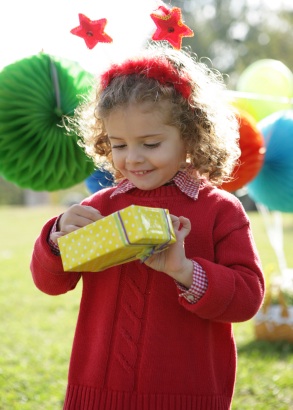So why do parents often start to panic months before the event? Sadly, eager anticipation quickly fades to jaded disappointment as we agonise over who should be invited, what would be the most suitable venue, how to organise catering, which games to plan, music to play, and what to put in the party bags.
The great news about birthdays is that there are no rules. It’s a good idea to start with a blank canvas and build the day up from there. Remember you and your child are the stars of the occasion, so focus on yourselves, rather than pleasing the crowd. If your child is old enough, include him in the planning, but remember who is paying, and who will do most of the preparation.
“Sometimes the smaller gatherings are the warmest and friendliest.”
Myth 1: You have to invite the whole class
Parents often feel that their child will be ostracised if they don’t invite the whole class or a particular circle of friends. And if you only invite a handful of children, won’t it look as if your child doesn’t have many friends? Other people will read what they wish into any situation, so you may as well do as you please. This could mean inviting just close family members, grandparents, a few families with children of different ages (rather than just the peer group) or some adults or neighbours who have a close connection with your child. Sometimes the smaller gatherings are the warmest and friendliest. The children feel more confident to play together and the adults have a chance to relax and chat too. You will need to be clear on whether you are happy for parents to leave their children with you on their own. Parents of school children seem more used to doing this, but if you are a home educator used to inviting whole families, you may be thrown if a parent announces he is off home and will return to collect his child later.

Myth 2: You need to book a hall, or a play centre
This is not necessary, but if you have a small house you may need to look for an alternative venue if you plan to invite more than a handful of guests. You could take advantage of the local park, with space to run around and perhaps swings and slides for entertainment. This is ideal for summer months, or winter too, if you are happy to brave the elements and can change plans at short notice if the outlook is too wet or cold. But try not to restrict yourself too much by thinking ‘party venue‘. The world really is your oyster, and the people you and your child love, are the only vital ingredients for the day. You could have a day at the beach with a picnic, go to a museum, visit Grandma for tea, meet up with Mummy or Daddy on their lunch break at a restaurant near work, go ice skating or roller blading… the list is endless. You may be surprised at how easily satisfied your child may be with just doing something different on their birthday. On a recent birthday, my son was happy to just eat cake in the bath before bedtime, like the cat in Dr Seuss’ The Cat in the Hat Comes Back.
Myth 3: Invitations must be written on specially bought notepaper.
Word of mouth, or a quick email or phone call may be adequate, particularly for small gatherings. I have learnt that enough advance notice (preferably 4 to 8 weeks) carries more weight than a written invitation. Parents of serious party goers with large circles of friends or acquaintances may find one of their children invited to a party nearly every week, and will want details in their diary as early as possible. They will need to know where the party is, which date and at what time. If you do decide on formal invitations, have fun making your own and don’t feel forced to feature the latest television character. You could try making your own paper, cutting out pictures, using pressed flowers and leaves, or have a go printing something out from the computer, perhaps with a photo.
Myth 4: You must organise games or hire an entertainer
This will probably depend on you and your child’s personalities, but again, there is no ‘must‘. My children prefer to run around and have fun with their scooters and bikes. That suits me, but other families may enjoy the traditional party games such as Pass the Parcel, Musical Statues or Musical Chairs, Pin the Tail on the Donkey or various treasure hunts. Moving away from the games idea, you could have a baking party, where children make and decorate their own small cakes, or perhaps pizzas. Alternatively, throw a gardening party, letting children plant seeds or cuttings or make miniature gardens, or have a sewing or knitting party.
Myth 5: There must be loud music, preferably of the party dance mix type
You don’t have to have music at all and may find there is enough noise with just your own family, before any guests arrive. It’s funny how children do seem to like music with a beat, but there are probably many different types of music that could be sampled. Certain over-played children’s songs or popular pieces can become irritating. Try Latin American or African music for a different style, or calm people down with classical music or panpipes.
“Offer wholemeal bread, provide bowls of cut up seasonal fruit or vegetables, falafels, rice, bean or chick pea salads.”
Myth 6: There has to be junk food
Just as an adult party doesn’t have to have alcohol, you can plan a child’s party without junk food but enjoy it just as much. You may choose fresh fruit juices or fruit smoothies rather than fizzy drinks, offer wholemeal bread, provide bowls of cut up seasonal fruit or vegetables, falafels, rice, bean or chick pea salads. If you are reluctant to do without any convenience food, you can serve it up in the healthiest way by making your own pizza, beefburgers, bread or cake. You can check that ingredients are organic, use less salt, choose fruit sugar, perhaps substitute carob for cocoa and generally have more control over the ingredients. Although cake is not obligatory, children quickly notice that birthdays usually involve a special cake. To avoid disappointment, be honest and realistic with your child from the start, about the cake possibilities you are offering. You can explain your concerns about too much sugar, but don’t fall into the trap of feeling you have to justify your decision to put health first. I have seen some pretty spectacular fruit displays instead of cakes, and have a recipe for a vegan carob cake that went down well one year.
Myth 7: You must have disposable plates, cloths and napkins
It may not be practical to cart a crate load of china, glass and steel to your party venue and then spend a few hours washing up at the end of a long day. Involve some consideration for the environment in your decision making. You may decide to buy washable but lighter reusable plastic plates and cups that you will set aside for party and picnic use in years to come. Biodegradable disposable plates, napkins and cutlery are also available.
Myth 8: You can’t have a party without balloons
My children love balloons, and I wouldn’t be allowed to plan a party without them. However, you should be aware of their environmental hazards and make sure you dispose of them responsibly. If you really want to splash out in an environmentally friendly fashion, try these eco-paper balloons made of Japanese paper coated with Polyvinyl Alcohol which is soluble in water.
“Party bags are not compulsory, but you may decide to give some kind of leaving gift.”
Myth 9: Each child must leave with a party bag
Party bags are not compulsory, but you may decide to give some kind of leaving gift. Instead of individual plastic bags you could let children select their gift from a tray or recycled box full of small gifts. Alternatively you may choose to make your own newspaper bag, containing small presents, or download and print out individual boxes or bags. Presents may be natural or homemade, including plants or seeds, felt purses, simple necklaces or hair bands, bookmarks made with pressed flowers.
Myth 10: Your children must write thank you letters
If your child is a reluctant writer, and receives a large number of presents, this could take several weeks or even months. My son does not enjoy writing at the moment, and I have no intention of forcing him to spend valuable playing in the garden or scooting up and down the alleyway time on writing. I’m not one for forcing verbal ‘thank yous‘ either, although fortunately my son has picked up on this social habit and enjoys saying it now. As the adult, I think it is my place to model what is usually done in society, and have always said “thank you“ if it didn’t come from my child. After the party, I make an effort to thank people again, when I next see them, or by phone or email. I then explain that they may get a thank you letter too if they are lucky! In quiet moments I try to suggest my older son try some thank you letters or emails, and leave him to choose the recipients.
However simple or intricately planned, you will want the party to be a memorable occasion for everyone. Don’t work so hard at pleasing everyone else that this time next year you will only remember stress, aching feet and a forced smile. Be sure to enjoy the moment yourself, mixing with guests, sampling the food, sitting down and watching the children having fun. Remember that in years to come, the pictures and thoughts in your head that day will be as important as the photos you took.







